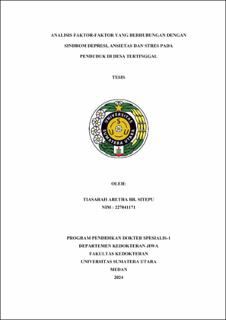| dc.contributor.advisor | Effendy, Elmeida | |
| dc.contributor.advisor | Arthy, Cindy Chias | |
| dc.contributor.author | Sitepu, Tiasarah Aretha Br | |
| dc.date.accessioned | 2025-01-21T06:01:56Z | |
| dc.date.available | 2025-01-21T06:01:56Z | |
| dc.date.issued | 2024 | |
| dc.identifier.uri | https://repositori.usu.ac.id/handle/123456789/100410 | |
| dc.description.abstract | Background: Mental health is a fundamental aspect that affects quality of life.
Depression, anxiety, and stress are important indicators of mental health disorders,
and the prevalence of these three disorders continues to increase globally. In
Indonesia, underdeveloped villages often experience inequality in access to mental
health services. Socioeconomic and demographic factors play an important role in
the incidence of depression, anxiety and stress syndromes, especially in rural areas.
Methods: This study employed a cross-sectional design with a cluster sampling
method. The Indonesian version of the DASS-21 instrument was used to assess
depression, anxiety, and stress syndromes in 376 respondents from Bagan Asahan
Village. Data were analyzed using multivariate logistic regression, and the
significance of the relationship was measured using the odds ratio (OR) and p value.
Results: Age was found to be significantly associated with depression (p=0.034),
with an OR of 1.74, indicating that pre-elderly residents were 1.74 times more likely
to experience depression than young adults after controlling for educational status,
marital status, and BMI. Income was significantly associated with anxiety
(p=0.001; OR=2.19) and stress (p=0.005; OR=4.38), showing that residents with
higher incomes were at greater risk of anxiety and stress compared to those with
lower incomes after controlling for other variables.
Conclusion: There is a significant association between age and depression, as well
as between income and anxiety and stress among residents of underdeveloped
villages. Pre-elderly individuals are 1.74 times more likely to experience depression
than young adults. Higher income increases the risk of anxiety by 2.19 times and
stress by 4.38 times compared to lower income. No other variables were identified
as confounders in these associations. | en_US |
| dc.language.iso | id | en_US |
| dc.publisher | Universitas Sumatera Utara | en_US |
| dc.subject | Depression | en_US |
| dc.subject | anxiety | en_US |
| dc.subject | stress | en_US |
| dc.subject | underdeveloped village | en_US |
| dc.subject | DASS-21 | en_US |
| dc.subject | mental health | en_US |
| dc.title | Analisis Faktor-Faktor yang Berhubungan dengan Sindrom Depresi, Ansietas dan Stres pada Penduduk di Desa Tertinggal | en_US |
| dc.title.alternative | Analysis of Factors Associated with Depression, Anxiety, and Stress Syndromes Among Residents of Underdeveloped Villages | en_US |
| dc.type | Thesis | en_US |
| dc.identifier.nim | NIM227041171 | |
| dc.identifier.nidn | NIDN0001057202 | |
| dc.identifier.nidn | NIDN0015088804 | |
| dc.identifier.kodeprodi | KODEPRODI11103#Ilmu Kedokteran Klinis | |
| dc.description.pages | 222 Pages | en_US |
| dc.description.type | Tesis Magister | en_US |
| dc.subject.sdgs | SDGs 3. Good Health And Well Being | en_US |


